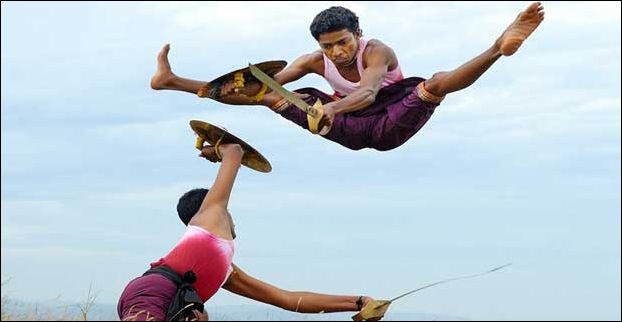The mentions of martial arts in the Vedas prove its existence in India for over 300 years. Kalaripayattu, the martial art originated as s style in Kerala during 3rd century BC to the 2nd century AD, is probably the oldest form of martial arts in India. The word ‘Kalaripayattu’ is a combination of two words namely ‘Kalari’, which means training ground and ‘payattu’ which means fight. So Kalaripayattu means practicing the arts of the battlefield.
Kalaripayattu is now practiced not only in Kerala, but also in fringes of Karnataka, Tamil Nadu and in Sri Lanka. It is a source of living for many people in Kerala because kalaripayattu performances are conducted for tourists. People even from foreign countries come to Kerala to learn Kalaripayattu, which shows the wide acceptance and recognition of these ancient martial arts from all over the world. We can influence of Kalaripayattu in the traditional arts forms of Kerala like Kathakali, Paricha kali and Paricha muttu. Many Kathakali artists, who learned martial arts, agree that it helps to improve their performance. Realizing the potential of Kalaripayattu, many institutes like School of drama and Pune film institute include this martial art form in their curriculum.
Legend behind Kalaripayattu

The founder of Kalaripayattu, as per the ancient folklore, is Parashurama, who was an avatar of Lord Vishnu. There is a belief that kalaripayattu arised itself out of Lord Shiva’s war against his father-in-law Prajapathi Daksha. Lord Shiva then taught Parasurama the art of Kalaripayattu, who later taught his 21 disciples and opened 108 kalari (schools) around the Kerala region. We can see reference to Kalaripayattu in the Rigveda and Atharvaveda. There is also an argument that kalaripayattu was developed in the forests, when hunters had observed the fighting techniques of various animals. Therefore, many movements of kalaripayattu are named after these animals.
History of kalaripayattu

Even though several martial art forms in India have been forgotten because of the neglect and lack of proper documentation of their existence, Kalaripayattu could retain its dominance till now. In earlier days, the children in Kerala had studied Kalaripayattu compulsory after the age of seven. It was during British period, the martial arts in India suffered major set backs. British, with an aim of quelling chances of any form of mutiny or rebellion among the natives, restricted the tradition of training with and carrying arms by implanting laws. But British underestimated the passion of Indians towards martial arts. People in rural areas practiced kalaripayattu secretely and kept alive during colonial period. Thus the main martial arts of India survived the dark times. After independence, kalaripayattu regained its glory and now anybody can learn this marital art form without hesitation.
Even though Kalaripayattu is based on Hindu tradition, many muslims in adopted and practiced this martial arts from. We can see the reference of muslims trained in Kalaripayattu in the ballads of North Kerala. For example, Tacholi Othenan (the hero of the northern ballads) bowed before Kunjali Marakkar, the Muslim comamnder of the Zamorin. Tacholi Othenan was killed by a Muslim discipline of Kadirur Gurukkal.
Styles of Kalaripayattu
There are differences in the performance of Kalaripayattu according to geographical position. Kerala has manily three styles of Kalaripayattu known as Northern Kalaripayattu (In North Kerala), Southern Kalaripayattu (In Southern Kerala) and central Kalaripayattu.
Northern Kalaripayattu
It was mainly practiced by a sub group dog Nairs called ‘PadaNairs’ and a sub groups of Ezhavas called ‘Chekavas’. You can see the stories of the kalari warriors of these groups in the famous vadakkan patukal or the northern ballads. The ballads that tells the story of Nair Thacholi family are known as ‘Thacholi pattukal’ and the ballads of Ezhava Puthooram family’ are known as ‘Puthooram Pattukal’.
Northern Kalaripayattu emphasizes on flexible movements, evasions, jumps and weapons training. Physical training, which is called as ‘meipayattu’, and full-body oil massage are the main elements of this style. The oil massage that includes stamping massage (Thirummal) and foot massage (Chavitti thirummal) helps increase the flexibility of practitioners. This system of treatment is based on Ayurveda, the traditional Indian medical science. There are several styles in Northern Kalaripayattu called Thulunadan style, Kadathanat style and arappukai etc.
Southern Kalaripayattu
Southern Kalaripayattu is mainly prevalent in south Kerala and Tamil Nadu and it is also called as Varma Kalai. It includes several stages of training such as chuvatu (solo forms), Jodi (Paired training), kurunthadi (Short stick), Neduvadi (long stick), Katthi (knife), Katar (Dagger) and Valum Parachayum (Sword and shield) Chuttuval (Flexible sword). Siddha vaidyam (Siddha medical system), which is distinct from north Indian Ayurveda, is used in southern styles of Kalaripayattu. It is traditional Dravidian system of medicine.
Central Kalaripayattu
The central Kalari style (Madhya Kalari), which is practiced mainly in northern parts of Kerala, has diverse techniques including heavy emphasis on application. It is performed within floor paths called Kalam. In this style, the participants start using weapons training only after acquiring expertise on lower body strength and speed through thorough practice of different chuvadus (Steps).
Kalari
The hall or ground exclusively prepared for training kalarippayattu is known as Kalari. Constructed based on vastu sastra, it has an entrance facing east and a main door located on the centre-right. There is a puttara (seven tiered platform) in the south-western corner. Kalari practitioners usually worship avtar of Bhagvathi, Kari or Shiva. The guardian deity is located in the Kalari and worshipped with flowers and water before training session starts. If southern style is practiced in the open air in an unroofed enclosure of palm branches, there is a special roofed pits with 3.5 feet depth from the ground level for Northern style. The purpose of this structure is to protect the practitioners from winds, which may hamper body temperature.
More than just a physical fitness training, Kalaripayattu practice aims at ultimate co-ordination of the mind and body. There are several kalaripayattu training centers across Kerala, where the skilled and experienced Gurus (teachers) provide proper and systematic training. Several tournaments are also conducted that give a golden chance to watch and know more about this ancient martial arts form.

Welcome to MithilaConnect, where we curate the art of living, celebrating the vibrant tapestry of life through culture, fashion, food, and everything in between.
